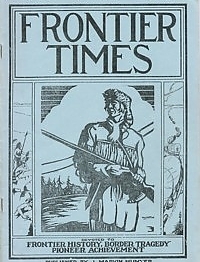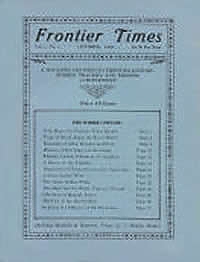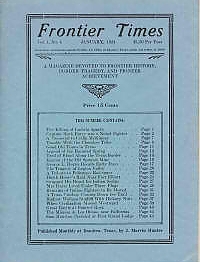By using our website, you agree to the use of cookies as described in our Cookie Policy
Magazines & Instant Downloads
Vol 12 No. 02 - November 1934
Sarah Ware Kincheloe - Frontier Heroine
By Aileen Penley Baldwin. Remarkable and riveting account of a true heroic pioneer. Sarah Ware was the eldest daughter of Capt. William Ware, who founded the Waresville settlement in Uvalde County in 1852, the remnants of which stand today a mile below the little village of Utopia in the northeastern corner of Uvalde County. Little Sarah was a child of 11 years in 1849, when she sat with her mother in a covered wagon that journeyed from Kaufman County seeking a new home on the Nueces frontier of Texas. Sarah was born April 6, 1838, her father, captain Ware came to Texas,in 1828, in the first tide of immigration to Texas, and settled on Ware's Creek, Montgomery County, where Sarah was born. On the journey, which ended ultimately in her father's settlement of Uvalde County, little Sarah's mother died from the hardships of the journey; so Sarah, and her sister, Eliza Ann, became the little mothers of the orphaned Ware children. In the new home on the banks of the clear, swift-sparkling stream, the Sabinal, the little Ware children played beneath the giant oaks and the shadowy cypresses, until the death of their father, Capt. William Ware, March 9, 1853, left alone in the frontier wilderness Sarah Ware with five younger sisters and a 13-year-old brother, John Ware.
An excerpt from this amazing story: "Sarah commanded the children to get under the bed, placing herself between the children and the. approaching Indians. There were two large doors to he house, and one was partly nailed and boarded, leaving a large opening. One of the Indian's arrows pierced Sarah's side from this opening, another lanced her arm, entering by way of a crack in the picket of the wall. Nevertheless, Sarah Ware Kincheloe stood before that door, before her babies, attempting to fire the useless rifle, while arrow after arrow hit her shoulders and breasts, all by miracle escaping a fatal portion. Finally, weakened by the loss of blood, and with 11 arrows piercing her body, she called feebly to the trembling Mrs. Bowlin to take her rifle and fight for the babies to her last breath. Believing she was dying, Sarah sank unconscious to the floor. When the Indians saw Sarah fall they rushed towards the room. Mrs. Bowlin stood with the gun limp in her arms in the center of the room, and the two Indians one at each door, raised their bows and simultaneously, two arrows pierced Mrs. Bowlin's heart. She sank to the floor and her daughters, Ella and Anna crept from under the bed to their dying mother…"
Further Mentions: Capt. Henry McCollough's rangers, Justice White, from New Foundland, Medina County, the Sabinal, Bandera,, Nueces and Frio canyons, Sarah's nearest neighbors were the Bowlins, a family also living on Little Creek, the Rev. John L Harper, frontier Methodist evangelist, Eliza Ware Fenley, Sarah's sister, John Davenport,
Indian Battle Hero Recalls Adventure
("Uncle Dick") Russell of Canadian, Texas, former Indian fighter, buffalo hunter and pioneer of the Southwest, relates a story of how he once killed six Indians single-handed and saved a family of four from being massacred. Further Mentions: the Solomon Valley of Western Kansas;
Interesting Note Regarding The Town Of Gonzales
Gonzales, founded in 1825, was a thriving town before Texas gained its independence from Mexico. The first flag of Texas was made at Gonzales by Miss Evaline De Witt and Miss Cynthia Burns. It consisted of a width of cotton cloth about six feet long, in the center of which were painted the following words: "COME AND TAKE IT." These words were the challenge to a Mexican general when lie demanded the surrender of a fort garrisoned by a small force of Texans. In 1903 a monument was erected in the Cost community, about six miles south of Gonzales, marking the spot where the first gun was fired in the war between Texas and Mexico. The inscription on the monument reads:….
The Passing of John Wright Coffey
By Mrs. A. T. Whetstone, Noxville, Texas. Good early Kimble County history. John Coffey was horn in Granbury, Hood county, Texas, June 21, 1856, the son of Rich Coffey and Sallie Greathouse Coffey, He came of a distinguished family and was himself distinguished. He came to Concho county with his parents when a small child. There his father established the famous Rich Coffey Ranch where John grew to young manhood. On December 31, 1874, at the age of 18 years, he was married to Miss Mary Brown. Seven children were born to this union five of whom survive. They are Sam Coffey of Alpine, Charlie Coffey of Dripping Springs, Jesse Coffey of Little Devil's River, Mrs. Nathan Walker of London, Mrs. D. H. Whetstone of Noxville, all of whom were present at his bedside when he passed away. One daughter, Mrs. Jesse Walker, died in 1919. His wife also died in 1919 and a son, Walter died in 1931. He is survived by one brother, Fog Coffey of Leaday.
Further Mentions: Little Devil's River, Miss Libbie Rush, Old Noxville cemetery, Rev. Lewis Pearl of London, Judge Weaver Baker, of Junction, John Van Coffey, Simon Walker, Lester Coffey, Clabe Walker, Albert Whetstone and Charlie Coffey.
Early History of the Klett Family
Fredericksburg (Texas) Standard. Early Comfort, TX area German settler, Charles Klett tells his interesting story. Mentions: His two brothers, Caesar and August left their home in Thueringen, Germany, and came to Texas, not to seek a fortune but by hard work, Miss Margaret Alberthal, Guenther Mill, Kerrville Road Crossing of the Live Oak, the present Albert Lindig ranch. Fredericksburg, John Alberthal, school at Luckenbach, the home of Mr. and Mrs. Wolfgang Braeutigain, parents of Otto and Henry Braeutigani of Fredericksburg. Mr. Louis Doebbler, a settler by the name of Heidman, an Indian fight about 7 miles east of Johnson City, Mr. and Mrs. Tom Filps who were massacred on Cypress Creek a few miles east of Round Mountain, Mr. Dollahite, father of Mr. W. W. Dollahite of Johnson City, a teacher, who was killed at Round Mountain, Doctor Assig, Mud Spring, a marshy place about 50 yards square. Indian fight at Big Mountain in 1873 five miles, southeast of Johnson City on Highway 20., Captain Ervin's Ranger company, August Klett married Miss Martha Wendel, the couple making their home in the, Cave Creek Community., Caesar Klett was married to Miss Mary Wiesemann and settled in Mason County., The children of Julius Klett are Charles and Emil of Johnson City, Mrs. Augusta Gold of Gold, Mrs. Lina Wiley of Austin, and Mrs. Annie Wilson of Robstown. Adolf Klett of Menard, Mrs. Lina Barker of Fort Worth and Louis Klett of Fredericksburg, Mrs. Lydia Heinemann, Mrs. Charles Dittmar, Albert E. C. Ottens of Fredericksburg.
The Cherokee Strip
Fascinating account of the land grab on September 16th, 1893.
An excerpt: "At five minutes before noon today 75,000 men were gathered upon the north and south boundaries of the Cherokee strip awaiting breathlessly the signal announcing the arrival of the hour when tile land was to pass from the ownership of the United States government into the possession of individual citizens. All were ready for the race to bring fortune and happiness to some, disappointment and suffering to others. All were expecting fortunes and all ready for the race for lands. Some were mounted on thoroughbred racers, some on less fleet but sure footed cow ponies, some on bicycles, others in buggies and wagons. An air of strained expectancy pervaded the throngs and each was eager for the signal.
Bang, bang! The revolvers of the United States army officers who have charge gave, the signal to start and the race was on. Thousands of men, women and children rushed over the boundaries and into the coveted land as if their very lives rather than a mere farm or town depended upon their going. The shouting of men, the screaming of women, the neighing of frightened horses, the cracking of whips, the creaking of prairie schooners, the rattling of wheels, the clatter of hoofs and explosion of firearms combined to make a confusion of sounds in keeping with the general confusion of the start and to render the scene one of Indescribable pandemonium." The total number nearly doubles the crowd which raced into Oklahoma when that. territory was opened.
A Destructive Hail Storm
N. H. Rose of San Antonio, has kindly furnished us with the following account of a destructive hailstorm, which visited Menardville, Texas, and vicinity on May 27, 1887, the account being taken from the Menardville Monitor of June 4th, 1887. Many of the older citizens of Menard county vividly remember the hailstorm, and will read this item with much interest. The account from the Monitor follows:
"Friday, the 27th of May, was a warm, sultry day, and about tire middle of the afternoon clouds could. be seen gathering to the northwest, and…"
Expedition Through Unexplored Texas in 1854
By W. B. Parker (Continued from Last Month.) The 2nd installment in a series of lengthy and detailed articles where the author shares his experiences while attached to the expedition commanded by Captain R. B. Marcy, to explore Northwest Texas in the Summer and Fall of 1854. Fascinating eye-witness & day-by-day journal of events on early frontier.
Nickajack Cave
Octavia Zollicoffer Bond. Fascinating and detailed account of dreadful events that occurred in and around this mysterious Tennessee cave
BETWEEN Nashville and Chattanooga, on rails that parallel the Tennessee mile after mile, you cross Sequatchie Valley. Midway at the station of Shellmound, you see the head of the fertile valley pillowed against Sand Mountain, where at the base of cedar-bristled cliffs, the vast cavern of Nicajack yawns, in savage contrast to the cultivated fields that reach almost to its gloomy entrance. Equally at variance with present civilized conditions is the background of history which points in dark perspective to cruel events in the past… Jack, a negro slave, ran away from his pioneer master, and took to the unlimited woods for freedom. Along the paths of the wild he went southward, a hundred miles or more, to where the river Tennessee (called by the Indians, Kalamuchee) dips, courtesying toward Alabama, about thirty-six miles below Lookout Mountain. By some means he crossed the wide stream to a strip of Woods that lay between the river and the abrupt end of Sand Mountain. In a region unknown to White. men, and uninhabited by Indians, Jack … took refuge in this cave, glad of a place in which to build a fire without danger of betrayal by ascending smoke. Here he cooked and ate and slept at ease, not suspecting that he was in the den of the Chickainaugwi, a fierce branch of the Cherokee Indians, who were in the habit of concealing themselves in the cave when pursued by their enemies. Broken would have been Jack's slumber, and brief his stay had he dreamed he had invaded the ill-famed Te-Calla-See, the cavern in which the notorious Chickamauga bandits secreted their stolen goods and tortured their fore-doomed captives.
Further Mentions: Colonel John Donelson's company of pioneers, who were "intending, by God's permission, to go to the French Salt Springs at the bluffs on Cumberland," the future site of Nashville, his daughter, Rachel, afterwards the wife of Gen. Andrew Jackson, as well as the family of the great pioneer, James Roberston.., Colonel Brown, the young men promptly killed, Mrs. Brown, and the children were given over to captivity, and their possessions divided among the pirates. Joseph, the eldest of the children, fell to the lot of Chea-Cliat-Alla, the younger brother of Dragging Canoe, who spared his life that lie might become the slave of his mother and her Irish husband, Tom Tunbridge., Cuttertoy, John Sevier and James Robertson; John Watts (Kunot Kelfig), "Chucky Jack" (John Sevier), William Trousdale, John Gordon, Colonel Montgomery, Colonel Whitley, Toni Tunbridge's cabin, William Pillow, Sequatchie Valley,
The Battle Creek Massacre
The Dawson. (Texas) Herald. Details the battle with 300 Kickapoo Indians which left 16 white pioneers dead on September 8th, 1833, about four miles from Hubbard, near Dawson, Navarro County,TX. The sketches of the fight in this story are furnished by survivors who were eye-witnesses to the event. Further Mentions: Jno. P. Cox, formerly of Hillsboro. Gen. Walter P. Lane, T. H. Dixon, E. M. Cox father of Sheriff Cox, James T. DeSchield, Richland Creek, (afterwards called Battle Creek), Franklin, in Robertson County, Parker's Fort. William Henderson, Captain Neill, Euclid M. Cox, Button, Tehuacana Hill, Gen. George F. Alford, Col. W. Love, Jackson, Smith, Violett, Grosbeck, Among the survivors in the ravine was a man by the name of Davis who hailed from San Augustine,
They found the dead body of the heroic Cox near where they had left him at his own request, to die alone in the lonely darkness of the night for the reason that he knew he had received his death wound, and that any attempt, to save him would be useless. When they left this hero on that fateful night life was not entirely gone from his body and a loaded pistol was left with him, but upon their return it was gone, and near him was pools of blood, indicating that he had dealt the death wound to at least another savage prior to the flight of his soul to that other world.
Brit Dawson's Pioneer Days in Navarro County
By Allene Loveless Fread.
Britton Dawson told many interesting stories to his children and grandchildren most of which stories have been repeated by his only living child, Mrs. Armanda Jane Fread, of Dawson, It was from this silver-haired lady, past 73 years old, that the writer has been able to gather much of interest about Dawson. She thinks it is good that people should know and appreciate the history of their own city and State. This writer, who has always known Dawson to be a peaceful, contented little town can hardly realize that less than a century ago Indian raids and massacres, horse thievery and cattle rustling made existence stirring for the first white settlers. Britton Dawson was born in Alabama July 15, 1817. His mother was Elizabeth Patterson and his father Dread Dawson, who was born in Greene County, Georgia, and served as a soldier during the second war with Great Britian. He was a farmer by occupation. At an early day he moved to Alabama, where he became a prominent and wealthy planter, having at one time as many as 100 negroes. In 1825 he disposed of his property and came to Texas, settling in Robertson County, where, he died in 1847.
Further Mentions: Miss Elizabeth Walker, a native of Mississippi., three children, Sarah, Henry and Elizabeth, Ritchie, Susanna Cannon, six children were born: Nancy, Mary, William Dread, David E., Louise and Armanda Jane, a grandson, Clint Lawrence, Mr. Berger, Only four children were born to the Dawsons after they moved into the new home, Anna, Emily, Britton C. and Elijah Franklin. Uncle Brit, as he was known, saw a lot of the history of Navarro county made. The county was created by the first session of the Legislature in 1846 and was organized during the same year. At that time it contained all of the territory now comprising the present counties of Navarro, Ellis, Tarrant, Hill, Johnson and part of McLennon. One of the most tragic Indian massacres of Texas History occurred near where Dawson now stands. It was after the well known Tehuacana massacre of the surveying party that Mrs. Dawson then a girl in her teens, helped pick up the wolf-eaten bodies of the unfortunates and Brit Dawson and others gave them burial.
Texas Cowboy Branded A Redskin
Brief but interesting tale of a Panhandle cowboy and an attacking Comanche. Excerpt: With his momentary advantage the cowboy put the spurs to his horse, raised his lariat and roped the Comanche. Then he dragged the Indian back to the still glowing fire and reheated the branding iron. The cowboy applied the iron to the Indian's hips, despite his yells of protest, then he brought out his knife and cropped the Indian's ears with the same mark used on his herd. "After this don't ever let anyone tell you you're a maverick, you're carrying one of the best brands in the Panhandle," the cowboy told the Indian. " And if I ever catch, you down this way again I'll come up to the Territory (Oklahoma Territory) and put the iron on the whole tribe."
$4.95
‹ Back








